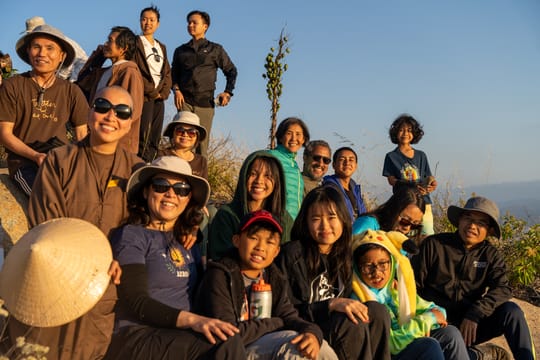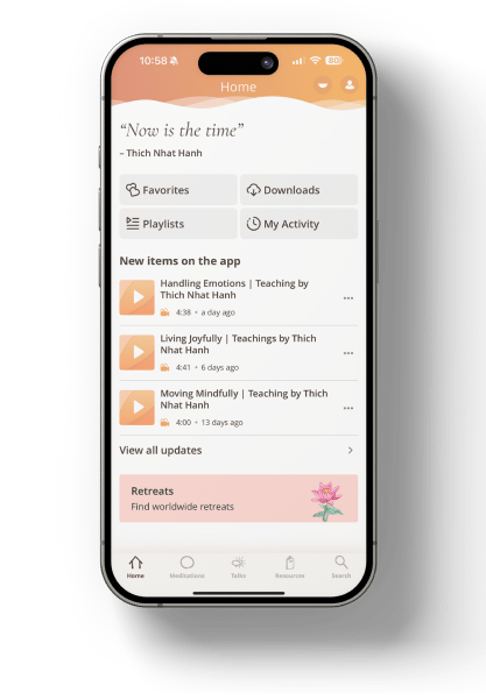Befriend your Strong Emotions with Sister Dang Nghiem
All human beings experience strong emotions, like sadness, anger, insecurity, jealousy, self-doubt, regret, yearning, etc. We all have them, but as a child we don't necessarily learn how to deal with strong emotions. Not at home, nor in school. While we do learn how to read, write and calculate, our inner world remains as untrodden territory.
Taking Care of Strong Emotions
Many of us suffer because we do not know how to handle strong emotions. When an unsettling feeling arises, we can tell ourselves: “Breathing in, I am aware of my emotion. Breathing out, I calm my emotions.” By doing this, we will find our mind settling down. This is crucial because mindful breathing has the capacity to calm unsettling emotions, whether they are despair, fear, or anger.
When strong emotions arise, we must return to ourselves and practice mindful breathing to generate the energy of mindfulness, protecting ourselves and being present for the emotion. Do not let the emotion overpower you. Do not become a victim of the emotion.
Just as we prepare our home to withstand a storm, we must fortify ourselves against the potential destruction caused by strong emotions. These emotions arise from deep within our consciousness, and the energy of mindfulness must also come from this depth. The practice involves sitting firmly in a chair with both feet flat on the ground, sitting on a cushion in a cross-legged position, or lying on a bed in a comfortable posture. Focus on the breath and direct attention to the lower abdomen.
Why focus on the lower abdomen? In a storm, if we look at the treetops bending in the wind, we may feel they are fragile and likely to break. But if we direct our gaze to the tree’s roots, we feel reassured, seeing the trunk firmly anchored, with roots deep in the earth, strong enough to endure the storm.
We are like a tree, and our emotions are like the storm. Without preparation, we can be swept away. Preparation means beginning mindful breathing and directing attention to the lower abdomen, below the navel. This is called “belly breathing.” By focusing on the rise and fall of the abdomen, we connect to our foundation, akin to the tree’s roots. Avoid focusing on the head, as that is where the storm rages most fiercely. Seek refuge at the tree’s base, below the navel, for safety.
This simple practice is highly effective. We must realize that an emotion is just an emotion—a small part of who we are. We are much more than our emotions. Emotions come, stay for a while, and then pass, like the wind. Knowing this, we no longer fear our emotions. Many young people suffer because they do not know how to handle strong emotions. They may believe the only way to end their suffering is to end their lives. Tragically, many young people have lost their lives unnecessarily because they did not know how to manage their emotions. In reality, this is not difficult. We need only recognize that emotions are transient. Why should we die for an emotion? We are far greater than our emotions.
When we focus on our abdomen for 15 or 20 minutes, practicing this mindfulness, the intensity of the emotion will gradually subside. We will feel peace and happiness because we know how to handle our emotions. We will gain confidence that, in the future, when strong emotions arise, we can manage them skillfully.
With this practice and trust in it, we can also help loved ones who are suffering from overwhelming emotions. We can invite them: “Come, sit with me, hold my hand. Let’s practice mindful breathing together and focus on the rise and fall of our abdomen.” By holding their hand, we transmit strength and confidence. Together, you breathe, and after 15 or 20 minutes, they will feel calmer. In the future, they may practice on their own. This simple guidance could save a life.
I encourage you not to wait for strong emotions to arise before starting this practice, as you might forget everything in that moment. Begin practicing now—15 minutes a day. Practice mindful breathing while sitting or lying down, focusing on your abdomen. Belly breathing can become deep, slow, and powerful. After three weeks of consistent practice, you will feel much steadier. Then, when a strong emotion arises, you will remember to practice and will find it easier to succeed. Gradually, the emotion will lose its power. There is no need to fight it. Simply allow the energy of mindfulness to embrace the emotion, and it will diminish, eventually returning to the depths of the subconscious.





